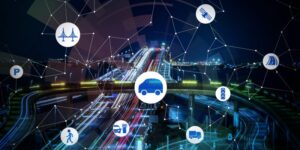
Transport and logistics, once the weakest link in the Indian development story can be overhauled with the help of geospatial technologies like GIS, AI, ML, IoT, and analytics.
While India’s transportation and logistics industry constitutes 5% of GDP, it handles 4.6 billion tons of goods amounting to ₹9.5 Lakh crores ($127.7 billion) annually, employing over 2.2 crore (22 million) people.
Increasing population and a shift in lifestyle patterns are constantly accelerating the demand for the movement of people and goods. According to NITI Aayog, the demand for the movement of goods is expected to increase at a compound annual growth rate (CAGR) of 7% and is projected to touch 15.6 trillion km by 2050. Recognizing the critical role of the sector in the country’s economic growth the Government of India (GoI) has allocated over ₹111 lakh crores (nearly $1.5 billion) under the National Infrastructure Pipeline for FY 2019-25. As part of the exercise, roads alone will account for 18% of the capital expenditure.
India has the second-largest road network in the world spanning a total of 5,890,000 km and transporting over 90% of the country’s population as well as 70% of its goods. Recognized as one of the largest railway systems in the world under a single management, the Indian railway network travels over 67,000 km across the subcontinent, plying 23 million passengers and 3 million tons of freight annually. At the same time, logistical costs in India amount to 14% of GDP, with transportation and inventory accounting for more than 90% of these costs. In India, costs are 30% higher for road transport and 70% higher for rail and coastal transport respectively when compared with countries like the U.S. These high costs are detrimental to both consumer spending and economic prosperity.
You can read the cover article in this series here
Challenges ahead
Road transport is energy and CO2 intensive and ends up being more expensive than other modes. Productivity of transportation by trucks in India is also low at 300 km per day compared to the global average of 500 to 800 km per day, with empty running rates as high as 40%. Already a concern, CO2 emissions from freight transport are projected to increase by 451% — from 220 million tons in 2020 to 1,214 million tons in 2050, which would negatively impact the food and water security of the country. Statistics released by the Ministry of Road Transport and Highways (MoRTH) for 2019 reveal that India reported 1,230 accidents and 414 deaths every day — nearly 51 accidents and 17 deaths every hour.
India’s rail network too is severely constrained and operates under its full capacity, while there is a compelling need to increase goods movement by rail to reduce the load on road transport and lower CO2 emissions.
As per NITI Aayog, a two-fold increase in freight movement by rail can lead to seven million fewer trucks by 2050, contributing to 388 million tons worth of reduction in CO2 emissions by 2050. In order to achieve this, it becomes imperative to improve existing rail network infrastructure, rail traffic and route management, and strengthen the intermodal network with ports and airports.
Slow technology adoption and inadequate digitization of transportation processes is a major challenge that is crippling the sector’s competitiveness and growth. As the backbone of economic activity, it goes without saying that technology will be the key enabler for transforming the transport ecosystem in order to realize India’s economic ambition.
According to the Office of the Principal Scientific Adviser (PSA) to the GoI, the future of the Indian transport industry will be carved by radical transformations through major disruptive technologies: intelligent transport systems driven by Industry 4.0, data analytics, Internet of Things (IoT), and Artificial Intelligence (AI) from Hyperloop to autonomous and remotely piloted vehicles. For the sector to transform holistically, contextualizing the challenges and understanding the relationships and interdependencies spatially becomes paramount. Geo-enabled transformation is the need of the hour that can address diverse ecosystem complexities and at the same time provide actionable intelligence for making informed decisions. Geospatial technologies will be a force multiplier for the digital transformation of India’s transport sector.



